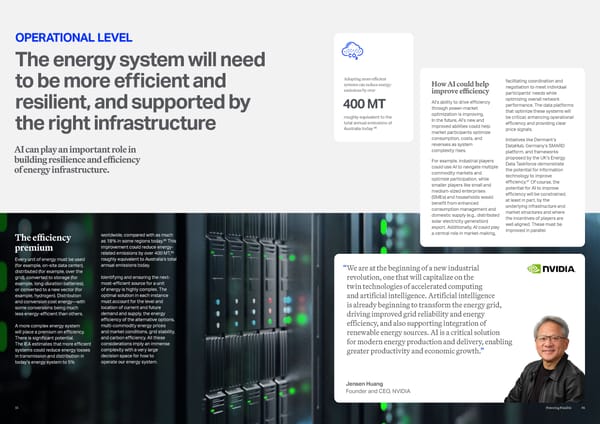Jensen Huang Founder and CEO, NVIDIA “ We are at the beginning of a new industrial revolution, one that will capitalize on the twin technologies of accelerated computing and artificial intelligence. Artificial intelligence is already beginning to transform the energy grid, driving improved grid reliability and energy efficiency, and also supporting integration of renewable energy sources. AI is a critical solution for modern energy production and delivery, enabling greater productivity and economic growth.” The energy system will need to be more efficient and resilient, and supported by the right infrastructure OPERATIONAL LEVEL The efficiency premium Every unit of energy must be used (for example, on-site data center), distributed (for example, over the grid), converted to storage (for example, long-duration batteries), or converted to a new vector (for example, hydrogen). Distribution and conversion cost energy—with some conversions being much less energy-efficient than others. A more complex energy system will place a premium on efficiency. There is significant potential. The IEA estimates that more efficient systems could reduce energy losses in transmission and distribution in today’s energy system to 5% worldwide, compared with as much as 18% in some regions today.95 This improvement could reduce energy- related emissions by over 400 MT,96 roughly equivalent to Australia’s total annual emissions today. Identifying and ensuring the next- most-efficient source for a unit of energy is highly complex. The optimal solution in each instance must account for the level and location of current and future demand and supply, the energy efficiency of the alternative options, multi-commodity energy prices and market conditions, grid stability, and carbon efficiency. All these considerations imply an immense complexity with a very large decision space for how to operate our energy system. AI can play an important role in building resilience and efficiency of energy infrastructure. How AI could help improve efficiency AI’s ability to drive efficiency through power-market optimization is improving. In the future, AI’s new and improved abilities could help market participants optimize consumption, costs, and revenues as system complexity rises. For example, industrial players could use AI to navigate multiple commodity markets and optimize participation, while smaller players like small and medium-sized enterprises (SMEs) and households would benefit from enhanced consumption management and domestic supply (e.g., distributed solar electricity generation) export. Additionally, AI could play a central role in market-making, facilitating coordination and negotiation to meet individual participants’ needs while optimizing overall network performance. The data platforms that optimize these systems will be critical, enhancing operational efficiency and providing clear price signals. Initiatives like Denmark’s DataHub, Germany’s SMARD platform, and frameworks proposed by the UK’s Energy Data Taskforce demonstrate the potential for information technology to improve efficiency.97 Of course, the potential for AI to improve efficiency will be constrained, at least in part, by the underlying infrastructure and market structures and where the incentives of players are well aligned. These must be improved in parallel. Adopting more efficient systems can reduce energy- emissions by over roughly equivalent to the total annual emissions of Australia today 96 400 MT 56 Powering Possible 55
 Powering Possible 2024: AI and Energy for a Sustainable Future Page 28 Page 30
Powering Possible 2024: AI and Energy for a Sustainable Future Page 28 Page 30